Radiators are an invariable component of any water heating system. They must effectively transfer the thermal energy of the hot water flowing into them into the surrounding space of the room.
In addition, do not forget about the aesthetic side. Based on these parameters, many are wondering: "How to choose heating radiators?" To do this, it is necessary to analyze their design and types.
Appointment
The water heating system consists of several important elements: the source of water heating (boiler or connection to a common central), piping and radiators. The constant movement of the coolant along the circuit provides heat transfer to the room.
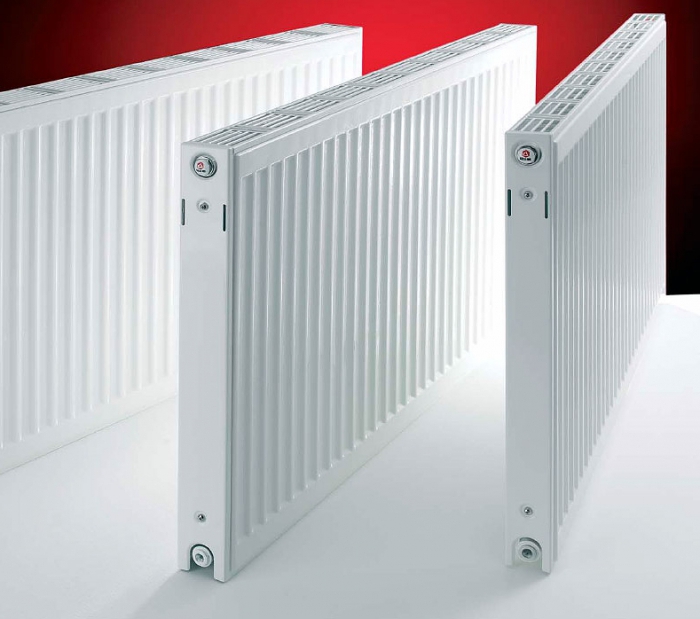
To increase heat transfer, it is necessary to use devices with a relatively large internal volume - thereby increasing the total heating area. Much depends on the type of construction and the material of manufacture. Which heating radiators are better: metal, steel or other products? First you need to find out their technical characteristics.
- Useful internal volume. Its increase leads to more thermal energy emitted from the surface of the device.
- The material of manufacture. Depending on it, the heat conductivity of the radiator, inertia (speed) of heating and external aesthetic properties change.
- Place of installation. Traditionally, radiators are mounted on a wall near window openings. But now you can find models located directly on the floor. Designer exclusive appliances were also especially popular. The place of their installation is not regulated - some may even serve as a dividing partition (bathroom, hallway).
How to choose heating radiators for optimal transfer of energy from hot water to the room? The next step in the analysis will be the operational characteristics of the devices.
Selection options
Experts say that the main criterion for selecting a heating device should be the operational characteristics of the heating system. These include: water temperature (maximum and optimal), pressure inside the pipes, method of connecting a radiator. In accordance with these parameters, manufacturers indicate certain characteristics of the heating device.
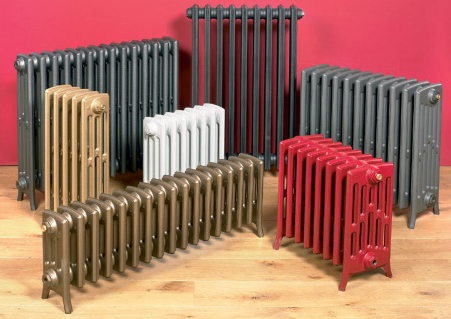
For the consumer, the amount of heat generated by the radiator is important. Many people mistakenly believe that the larger the surface, the better the device will work. However, this is far from a determining factor. It is important to consider the following characteristics:
- The material of manufacture. It affects not only the appearance, but also the heat transfer of the device. The best indicators are aluminum and steel models. For cast-iron radiators, heat transfer is slightly lower, but they retain heat on the surface much longer after the coolant has cooled.
- Rated power. This parameter determines the amount of thermal energy transmitted from the surface of the radiator to the surrounding space. Depends on temperature condition heating work. Measured in watts.
- The value of the optimal and maximum pressure in the pipes. Before choosing heating radiators in an apartment, you need to find out exactly this parameter. The operation of the central heating system is characterized by sharp pressure surges. In this case, it is best to choose cast iron models.
These are the main operating parameters by which to choose a heater.But, in addition to this, it is necessary to take into account the specifics of the radiator device.
Types of structures
Currently, 2 types of heating devices are produced - panel and section type. They differ in their operational characteristics, technical parameters and appearance.
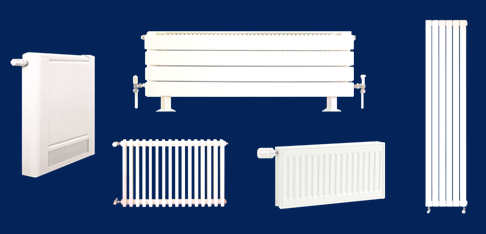
How to choose heating radiators, based on the design features? Consider each view in more detail.
- Sectional
These models consist of one or more sections connected to each other through the upper and lower nozzles. Similar designs are characteristic of bimetallic, aluminum and cast iron radiators. The advantage of their installation is the ability to choose a model of any width - the sections are connected to each other. But this procedure is performed using crimping on special equipment. Therefore, before purchasing, you can order a radiator with a certain number of sections.
The disadvantages of such devices include a reduced heating area, since the space between the individual elements is not filled.
- Panel
They consist of a piping system through which the coolant flows. The connection to the external panel is organized using numerous heat exchange plates. Heat is transferred through them from the heating elements to the outer panel.
This design is typical for steel radiators. The obvious advantages of this system include the affordable cost and a large selection of models in size. However, the solidity of the device does not make it possible to increase power by adding new elements.
Which heating radiators are better - panel or sectional? This is largely determined by the material of manufacture.
Steel
The use of steel for the manufacture of heating appliances is due to its good technical parameters. It lends itself well to processing - stamping, welding. Compared to other materials, such designs have the most affordable price.
Steel radiators can be either panel or sectional. But most often monolithic models are made, since this method is quite simple - as a result, reliable heating structures are obtained.
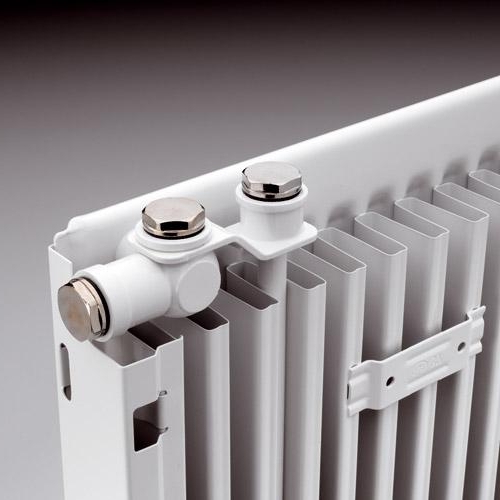
If the question is "which heating radiator to choose with a minimum budget", then steel will be the best solution. When choosing, the following equipment characteristics should be considered:
- The maximum water temperature is up to +120 ° C.
- Nominal operating pressure in the system is up to 1.5 MPa.
- Panel steel thickness - up to 1.2 mm.
- Height - from 300 to 700 mm.
You also need to know the types of steel radiators. They are characterized by the number of heat exchange circuits. Depending on this characteristic, there are single-circuit (11), two- (22) and three-circuit (33) models. The most widespread are two-layer devices, since they have optimal thermal parameters.
The shortcomings of steel structures experts include a short service life. This is due to the relatively rapid rusting of the surface under the influence of water.
Sectional devices are several pipes connected to each other in a welded manner. These are mainly designer models designed to create a unique interior.
Bimetallic
Recently, bimetal heating radiators have become most widespread. How to choose the best option from a wide range of these devices? First we learn about the specifics of their design. They combine the advantages of steel and aluminum models.
The system of internal pipelines made of steel or copper is connected by pressing method to external aluminum panels. Due to the high thermal conductivity of the latter, the rate of transfer of thermal energy from water to the room is fast enough. The sectional principle allows you to increase the power of the device depending on the technical requirements.
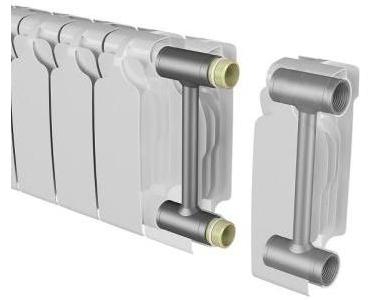
Bimetallic radiators are characterized by good performance. In addition, they have truly unique technical characteristics:
- Heat dissipation - from 170 to 190 watts (one section).
- Nominal pressure - up to 1.4 MPa. Such a good indicator is explained by a reliable connection of metal pipes.
- The center distance (between the upper and lower horizontal channels) is from 200 to 800 mm.
- The maximum temperature of hot water is up to 130 ° C.
Experts assure that these devices are optimal for installation in apartments with central heating and in houses with autonomous. The only drawback of such models is the relatively high price. This is due to the complexity of their manufacture.
Therefore, when deciding on how to choose heating radiators for a private house, first of all, pay attention to this type of heating device.
Aluminum
The choice of this material of manufacture is due to its unique characteristics of thermal conductivity. Thanks to them, the aluminum structure transfers heat energy faster than others from water to the room. Externally, they are no different from the bimetallic models discussed above. However, instead of steel pipelines, the coolant flows through the internal channels of the structure.
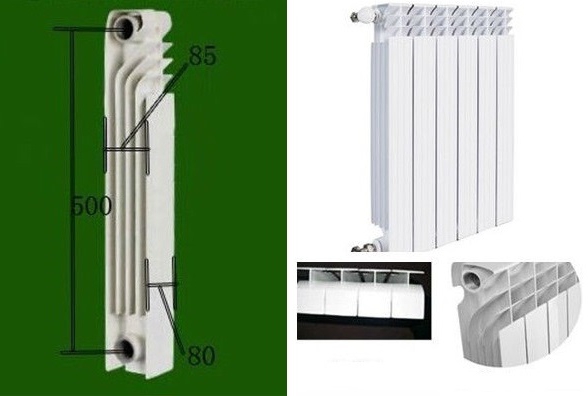
To connect the individual sections in the passage channels, steel cylinders with an internal thread are pressed. However, this cannot ensure the proper value of the maximum pressure of the device.
Which radiators are better - bimetallic or aluminum? With the exception of the pressure parameter, their operational characteristics are almost similar. However, the cost of aluminum models is 15-20% lower than bimetal ones. Therefore, they are most often installed for an autonomous heating system with constant monitoring of pressure in the pipes.
Technical specifications:
- The maximum pressure is up to 1 MPa.
- Pressing pressure - up to 10 MPa. This parameter indicates with what force it is necessary to act on the junction to connect the individual sections.
- Heat dissipation - from 90 to 160 W (for 1 section).
The use of new alloys of aluminum with silicon should improve these characteristics. But at present, there are very few such models on the market.
Cast iron
How to choose heating radiators for a system with high internal pressure? For this, cast-iron models are best suited. This manufacturing material is characterized by high strength, but has a low thermal conductivity, i.e., has a high inertness of heating. This must be taken into account when selecting a specific model.
Their design is quite simple - several hollow sections are connected to each other through the upper and lower horizontal pipes.
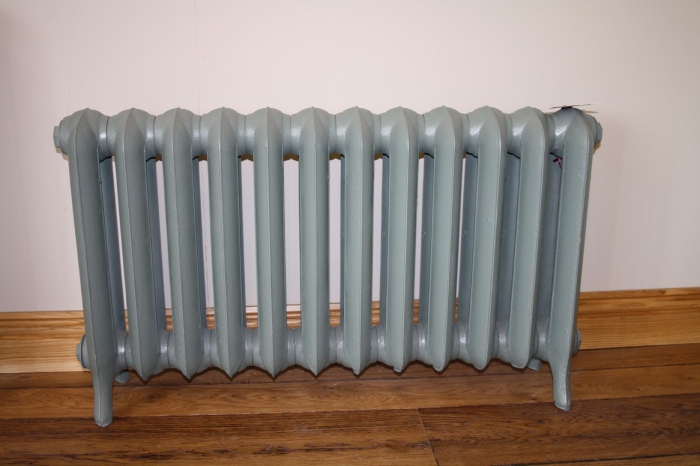
Depending on the type of construction, cast-iron radiators can be one-, two- or three-channel. This parameter determines the specific heat transfer of one section. But the more parallel pipes in the device, the wider the design will be, which is not always acceptable.
The operational features include high resistance to hydraulic shocks, which are characteristic of a central heating system. In addition, it should be noted such technical characteristics of devices:
- Heat transfer - from 80 to 210 watts. This is the widest range among all considered devices.
- The center distance is from 200 to 1000 mm.
- The maximum pressure is up to 2 MPa.
However, most models of cast-iron radiators are now presented in design options. How to choose heating radiators, reviews of which are not so easy to find because of the high cost and low demand? In this case, experts advise paying attention to the manufacturer. In most cases, models of good quality are produced in factories in Italy, Finland, and in some cases in Turkey.
Payment
After the optimal type of heating device has been determined, you should calculate the power that heating radiators should have. The calculation for large rooms is quite complicated. It takes into account the operation of ventilation systems, heat losses through window and door openings, as well as external walls.
When designing a heating system, a simplified calculation form was adopted - for 10 m² 1 kW of thermal energy is needed. That is, if the total quadrature of the room is 20 m², then the total power of the radiators should be at least 2 kW. To compensate for extremely low outdoor temperatures, it is recommended to add 10% to this indicator. As a result, the power of all heating devices in the room should be 2.2 kW.
Connection Methods
Another important factor is the way radiators are connected to the heating system. The efficiency of devices depends on this, since with a different length of the internal pipeline, the rate of decrease in water temperature changes.
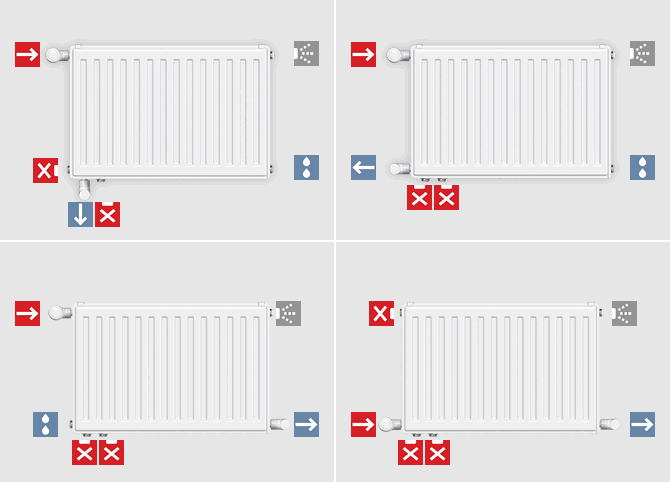
What do experts say about this? It is best if the connection is made at the top of the radiator, and the return pipe will be led through the opposite side panel. In this case, the length of the line will be optimally short, but at the same time, the coolant will have time to transfer part of its energy to the surface of the device.
Repair work
Modern designs of radiators are characterized by a high degree of reliability. However, this is not an axiom. Since any external factors can affect the integrity of the case or a hidden factory defect will manifest itself. How to choose heating radiators so that the process of their repair takes a minimum of effort and money?
Experts say that you must initially purchase good quality products from a reliable manufacturer. In terms of the complexity of the repair work, bimetallic radiators have proven themselves best. When breaking the internal pipeline (which happens very rarely) with the help of simple tools, you can quickly disassemble the structure and change the faulty section, or completely remove it from the general unit block. Cast iron, and even more so panel steel models cannot be repaired in this way.
Is it possible to quickly find the best radiators in design? Which are better to choose - aluminum, steel or bimetal? As mentioned above, it all depends on the actual operating conditions and parameters of the heating system. Only on the basis of these data can we determine the optimal model of a heating device.








